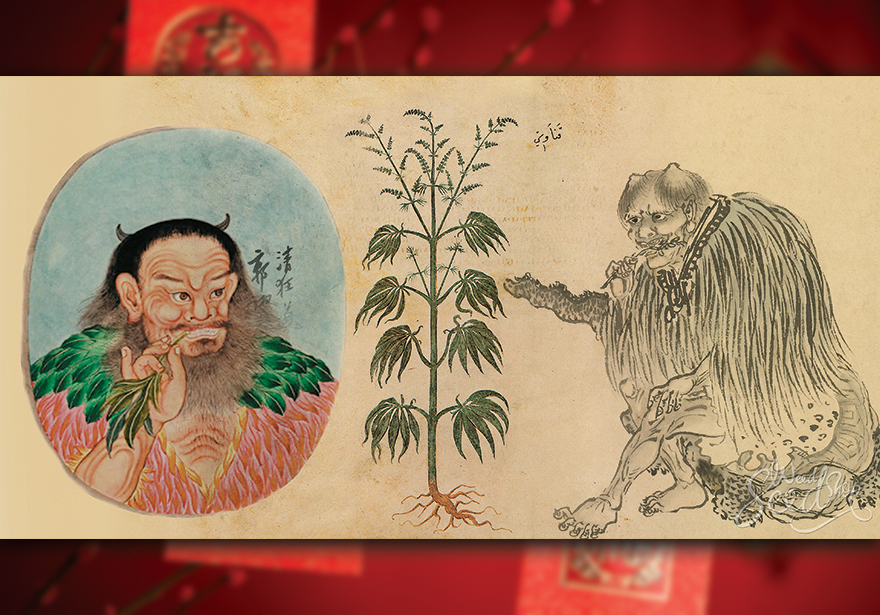The ancient history of the cannabis plant begins in Taiwan and China, and is both fascinating and shrouded in a bit of myth and mystery. Historians and researchers aren’t entirely positive about some of the dates or how historical events exactly were recorded in ancient China, and a number of similarly named mythological and legendary figures are credited in stories as having invented or created some of the same early technological innovations, as well as sharing some similar heroic feats they accomplished in China’s oldest folklore tales. There are some differences of opinion amongst archeologists and anthropologists, but generally they agree on the basic timeline and earliest records, and the fossil record is hard evidence that helps to fully illustrate the rich history of cannabis in ancient Chinese culture. Hemp cord in pottery was discovered at an ancient village site dating back to 8000 BC, located in the area of what is now modern day Taiwan. 2000 years later in 6000 BC, there is evidence that cannabis seeds and oil were being consumed as a food source in China, and 2000 years after that, in 4000 BC, hemp was being used to create high quality Chinese textiles.
Not long after that, historically speaking, legend says that in 2737 The Mythological Emperor Shen Nung first used Cannabis as a medicine. Shen Nung is considered by some to be the Father of Chinese Medicine, and by others to be a higher deity, Culture Hero, and God Farmer, and was said to be horned, ox headed, and bronze skulled. Artwork from the Han Dynasty depicts legends of The God Farmer “Shennong” teaching mankind how to use the plow along with other basic concepts of agriculture like the hoe and irrigation. Shen Nung is a heroic figure in the legends of Chinese Medicine and is credited in some myths of having also created acupuncture. He is said to have tasted 365 plants, seeds, and flowers in his search to discover and explore for medicinal properties, and cannabis was among them. In some versions of the legend, he died from an overdose upon tasting his 365th plant. “The Shennong Bencaojing”, also known as The Classic of Herbal Medicine, was a treatise on Chinese Medicine and had descriptions and entries for the 365 herbal medications discovered by Shen Nung, who the work is attributed to. Historians believe The Shennong Bencaojing was written between 200 and 250 AD, and was a collected compilation of oral traditions. Cannabis was one of the 120 plants covered in the first volume, which was various “upper” and “noble” drugs that were considered harmless to humans but beneficial due to their stimulating properties, including the psychotropic effects of cannabis. The Cannabis flower was said to cure over 100 different ailments in the ancient medical text.
The Yanghai Tombs near Turpan, Xinjiang-Uighur Autonomous Region, China were excavated and revealed a 2700-year-old grave containing a large stash of cannabis, excellently preserved thanks to the climate of the specific burial conditions. The Oxford Academic Journal of Experimental Botany reported that an international and multidisciplinary team of scientists was able to demonstrate through phytochemical investigation and botanical examination that the ancient cannabis found in the Yanghai Tomb contained the cannabinoid Tetrahydrocannabinol, also known as THC, the psychoactive component of marijuana.
Bu-Wei Leu’s Book of Songs, a collection of ancient Chinese social customs generally believed to have been assembled around 300 BC, mentions cannabis as being one of six crops regularly planted. There is evidence in The Chinese Canon of Rites, believed by some to have been compiled by the philosopher Confucius, that hemp fabric and rope had been invented in China by 200 BC, and fossil records prove that 100 years later Chinese hemp paper had been created. Cai Lun was a Chinese eunuch and official during the Han dynasty and used hemp in the composition of paper in the oldest forms of the modern papermaking process. Hua Tuo was an ancient Chinese Physician and Surgeon who lived in The Han Dynasty and was famous for his exceptional abilities in acupuncture and herbal medicine. He is credited with being China’s first surgeon and with discovering the invention of anaesthetic by crushing cannabis into a fine powder and mixing it with wine. The Chinese term for anesthesia is mázui, and literally translates as “cannabis intoxication.”
Hemp was also an important innovation in the history of Chinese archery and warfare. Bowstrings made from hemp were far superior to the bowstrings that had traditionally been made from bamboo fiber, and completely revolutionized ancient Chinese warfare. Hemp bowstrings were much stronger and more flexible, making them far better for long range archery and eventually being much more adaptable for using a bow while mounted on horseback. Monarchs would reserve sizeable portions of farmland specifically for growing hemp, making it the very first war crop. By 1500 BC, cannabis was being regularly cultivated in China for both food and fiber. In his book “The Dragons of Eden: Speculations on the Evolution of Human Intelligence”, famed astrophysicist, astronomer, and the original host of Cosmos, Carl Sagan speculated that “the cultivation of marijuana led generally to the invention of agriculture, and thereby to civilization.” That basically means that the world’s actual oldest profession, is also the newest and fastest growing industry in the modern world.
The history of Cannabis is vast, rich, incredibly intriguing, and it began in Ancient China. It will be very interesting to see what comes next. We’re forging new history every day, and we have China to thank for it. So say thank you to China, or Xièxiè Zhonghua!
Patrick Ian Moore
